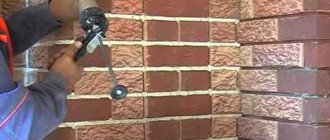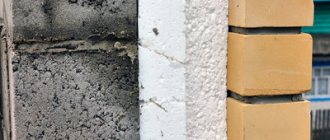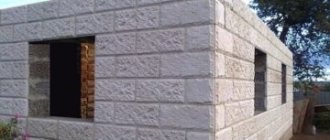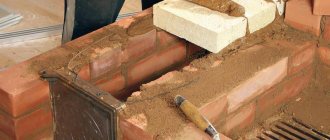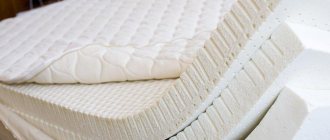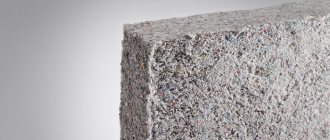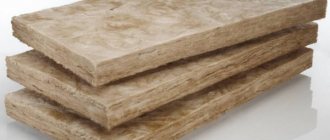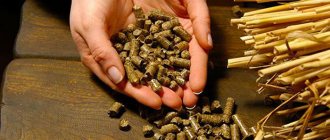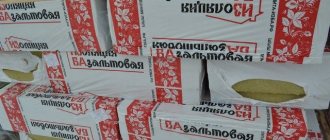As technological progress moves forward, more and more new materials appear for building houses with your own hands. If earlier it was limited to wood, stone or brick, today there are various types of concrete that are superior to other materials in terms of characteristics. One of these materials is wood concrete. This is a unique material that combines the advantages of both concrete and wood. Its composition is quite simple, and you can prepare the solution yourself. It is noteworthy that it can be used like ordinary concrete, by pouring the mixture into formwork, or it can be made in the form of blocks for ordinary masonry. Arbolite blocks can be bought in a specialized store, or you can prepare the solution yourself by making blocks from the finished mixture.
All you need is to know the exact composition of wood concrete, the proportions for mixing the mixture and the technology for its preparation. Let's take a closer look.
Arbolite block - what does it consist of?
The wood concrete from which wood concrete blocks are formed for masonry consists of 3 main components:
- aggregate;
- mineral binder;
- chemical additives and water.
By combining all these elements, an arbolite mortar is obtained, which is subsequently used to form blocks. The composition is quite simple and everyone can make the material for their own purposes. The material itself is light, so the blocks are ideal for the tub. Their advantage, compared to gas blocks and foam blocks, is their greater strength limit. They are resistant to cracks and impacts.
Despite the fact that the main component is sawdust (chips), wood concrete is highly valued and is not inferior in characteristics to traditional materials. On the contrary, wood concrete blocks retain heat well and create a good indoor microclimate.
About the material
Arbolite block is a large-sized masonry stone used in construction as a wall material and thermal insulation material. The main components of the arboblock are binder, filler, chemical additives that ensure accelerated maturation of the material, frost resistance, mineralization of wood chips, and water.
Blocks are produced in different regions of different sizes, this is due to the provision of enclosing structures with the required heat transfer resistance standards:
- in the central part of Russia , where a wall thickness of 390 mm is sufficient, blocks are produced in standard sizes 500x200x300, 500x250x200 and 500x200x200;
- in the northern regions, the Volga region and further to the East , where a wall thickness of 410 or 450 mm is required, the block has dimensions of 600x410x200, 450x250x300.
Manufacturers adjust the block sizes to the needs of the regions for the convenience of the consumer.
Products made from arbocrete are produced for different purposes:
- heat-insulating blocks and slabs with compressive strength class B0.35...B1.0, and density 400...500 kg/m3;
- structural blocks and slabs with compressive strength class B1.5...B3.5 and density 500...850 kg/m3.
Arbolite structural blocks are intended for the construction of residential buildings up to 3 floors high.
Main characteristics of wood concrete blocks:
- light weight - buildings do not require a powerful foundation, costs for handling equipment are reduced, and installation speed increases;
- low thermal conductivity - to ensure the required heat transfer resistance of an external building envelope in the Moscow region, a 370 mm thick wall made of D 600 block is sufficient;
- vapor permeability - the material breathes, creating a comfortable microclimate inside the building;
- biostability - walls are not affected by mold or mildew, rodents are indifferent to the material;
- fire resistance - flammability group G3 (low-flammability);
- environmental friendliness - all components of the material are of natural origin and do not emit harmful substances during production and operation;
- durability - some buildings have crossed the 50-year mark;
- ease of processing - the material is easy to cut with a circular saw, holds nails and screws well.
The disadvantage is water absorption from 40 to 85% of the volume ; to reduce this indicator, the filler is pre-dried and treated with various chemicals. It is forbidden to lay out arboblock structures that are subject to heavy atmospheric load - plinth, cornice, parapet.
For more information about the advantages and disadvantages of the material, see this article.
Organic filler
The lion's share in the composition of wood concrete blocks is occupied by wood chips. This is the main material that is included in its composition. Such organic filler can be easily purchased for little money. It is worth contacting a local sawmill where there is wood processing waste and negotiate with the workers. Coniferous trees and hardwoods are mainly used. Fir, pine, spruce, aspen, beech, birch and poplar are ideal for making wood concrete mortar. You can also use flax fire.
The most commonly used wood filler is: crushed wood, shavings with sawdust, in a ratio of 1:1 or 1:2, wood chips, shavings and sawdust, in a ratio of 1:1:1. All proportions are measured in volume. For example, if you need to achieve a ratio of 1:2, then take 1 bucket of sawdust and 2 buckets of shavings. Sawdust can be easily replaced with flax or hemp stems; this will not affect the composition.
What are the requirements for the filler? First of all, it is important to choose the right size. It is not recommended to use large sawdust, because when the products come into contact with water, they may increase in volume. As a result, the block may collapse. If you use particles that are too small, the consumption of the cement mixture increases. The recommended particle size is 15 or 25 mm long and no more than 2–5 mm wide. Raw materials should not have leaves or other impurities.
Warning! Larch and freshly cut wood of any species are not added to the composition of arbolite solutions. It is forbidden!
Bonfire flax
A complete filler added to the solution is flax flax. Since it contains sugar, chemical additives must be used. To improve the quality of the finished mixture for blocks, the fire is pre-treated with limestone milk, in the proportion: 200 kg of fire per 50 kg of lime. Then everything is kept in a pile for several days, after which everything is ready for the production of wood concrete. Thanks to this technology, cement consumption is significantly reduced. 1 m3 of wood concrete requires 50–100 kg of cement.
Important! If flax bonfire is used in its usual form, then hemp stems require some processing. They must first be crushed.
Due to the fact that organic waste contains water-soluble substances, including resin acids and sugar, this prevents good adhesion between particles. To remove sugar, wood chips must be exposed to air for 3 months or more, or treated with limestone. In the second case, the mixture is aged for 3–4 days. The contents are mixed 2 times a day.
Features of application in construction
Due to high moisture absorption, monolithic wood concrete requires specific measures for waterproofing walls :
- the distance from the planning ground mark to the bottom mark of the wall must be at least 50 cm;
- on the top of the foundation or plinth it is necessary to lay a layer of waterproofing material or a cement-sand screed with waterproofing with liquid glass;
- protect façade surfaces with plaster, cladding or curtain façade;
- cornice overhang - at least 50 cm.
Structural wood concrete is used for the construction of monolithic external walls with removable or permanent formwork made of plywood, moisture-resistant chipboard or OSB, and boards. Permanent formwork serves as a finishing layer. When using removable or sliding formwork to level the layer and reduce the consumption of cement for subsequent finishing, it is better to wrap the boards with PVC or polyethylene film.
Installation of permanent formwork. We immediately get the façade finished.
Structural wood-reinforced concrete during the construction of 2-story cottages will require additional reinforcement or a load-bearing frame , as well as the installation of reinforced belts under the floor and coating slabs.
Thermal insulation material is used for the insulating layer in masonry or three-layer walls. It can also be used in the construction of frame houses to fill cavities.
Attention!
When installing reliable waterproofing, a screed made of monolithic wood concrete can be used to insulate the floor of the first floor on the ground, over the ceiling, including the attic.
Frame elements in contact with the wood concrete mixture must be protected : metal from corrosion, wood from rotting. The frame racks are installed in increments of 1.2-1.5 m, at the openings of windows and doors. To reduce the load on the walls and foundation, it is recommended to carry out ceilings using wooden beams.
The façade and interior surfaces of wood-concrete walls require protection from moisture. This can be plastering, facade cladding with curtain panels, tiles or bricks, plasterboard cladding, plaster or interior wall cladding.
Mineral binder
There is no way you can make a solution with your own hands without a binder. It makes wood concrete blocks durable and suitable for masonry. Portland cement grade M400, M500 or even higher is used as a binder.
Its consumption depends on the type of aggregate, particle size, cement brand, characteristics, etc. To get a little guidance, you can determine the consumption this way: factor 17 must be multiplied by the required brand of wood concrete. For example, you need to prepare a solution, grade 15 (B1). In this case, 1 m3 of wood concrete will require 255 kg of cement.
conclusions
In a comparison of block and monolithic wood concrete, the characteristics of the materials are visible: construction from monolithic material is cheaper due to reduced transportation costs and the amount of cement, but it requires a lot of labor time for preparing wood chips and pouring the monolith.
At the same time, houses made from both types of wood concrete require enhanced protection from atmospheric moisture and reinforcement in the case of building a 2-story house. Both construction methods have the right to exist, the choice is up to the homeowner.
We tried to write the best article. If you liked it, please share it with your friends or leave a comment below. Thank you! Great article 5
Chemical additives
The properties of wood concrete blocks directly depend on chemical additives. Their use is mandatory in any case, no matter in what climate the work is performed. Thanks to additives, the filler can be used without aging, because they neutralize sugar and other substances, which improves the quality of the finished blocks.
Such additives can be used:
- liquid glass (sodium silicate). It closes all the pores in the wood, so moisture will not get inside. Used after removing sugar;
- slaked lime. It breaks down sugar and kills microorganisms in sawdust;
- aluminum sulfate. Excellent at breaking down sugar. Thanks to the component, the composition gains strength faster;
- calcium chloride. Kills all microorganisms and gives wood anti-rot properties.
Aluminum sulfate and calcium chloride are considered the best additives. The proportions of additives are 2–4% by weight of cement, or from 6 to 12 kg per 1 m3. Additives can be combined with each other.
Properties, advantages and disadvantages
For a private developer, when choosing a building material, the technical characteristics of the material are important. Let's look at wood concrete blocks from this side. So, the characteristics and their brief explanation:
- Thermal conductivity - 0.08 - 0.14 W/m°C (depending on density, the higher the density, the higher the thermal conductivity). Characteristics comparable to wood. It has this indicator of 0.14 W/m°C, for ceramic brick it is 0.6-0.95 W/m°C. That is, a building made from arbolite blocks will be warm, and the width of the walls will be small. For central Russia, in permanent residences, it is recommended to make walls 30-40 cm thick.
- Frost resistance - 25-50 cycles. This parameter means that the walls can freeze/thaw from 25 to 50 times without compromising their qualities (depending on the manufacturer). If the house is a permanent residence, then it will not freeze at all. For unheated dachas, a service life of 25-50 years is quite acceptable.
- Compressive strength - 0.5-5 MPa. This is one of the most attractive features of wood concrete - it is difficult to destroy. Another point: it restores its shape after removing the load. That is, hitting with a sledgehammer can make a dent, but after a while it will level out - partially or completely depending on the “severity” of the damage caused.
Technical characteristics of arbolite blocks - Bending strength 0.7-1 MPa. This means that if any distortions appear in the structure (the foundation has settled unevenly), the wood concrete blocks will not burst and will compensate for a sufficiently large load.
The properties are very good. Another thing is that they will only be provided that the proportions and technology are strictly observed. This is why arblite blocks are dangerous: you don’t know how well they are made.
Performance characteristics
As you can see, the characteristics of the arboblock are quite good. The advantages also include light weight, large size and good ability to absorb sounds. A very big plus is that the blocks are easy to cut and can be easily given the desired shape. Another positive point is that wood concrete holds nails and screws well. There are no problems on this side either.
- Shrinkage - 0.5-0.6%. This parameter shows how much the geometric dimensions of the wall will change under load. Wood concrete has one of the lowest rates.
- Water absorption 40-85%. This figure is very large. If you put an arbolite block in water, it can absorb a lot of water. For the developer, this means that care must be taken to ensure good waterproofing between the foundation and the first row of blocks. An arbolite house also needs exterior finishing that will protect the material from moisture. It's not all that scary. It is much more important that the hygroscopicity of wood concrete is low (the ability to accumulate vaporous moisture). Even with very humid air, it does not become damp, but allows vapor to pass through itself, regulating the humidity in the room.
- Fire resistance - class G1. Arbolite refers to materials that do not support combustion. This is their undoubted advantage.
If we talk about technical characteristics, then there is essentially one serious disadvantage - high water absorption. There is one more drawback, but it is from the field of operation. Mice love arbolite very much. The material is natural and warm. The problem can be solved by making a high base - no lower than 50 cm.
Proportions for arbolite blocks
To make wood concrete blocks with your own hands, it is important to know not only the composition, but also the proportions. The ratio of all components to each other is as follows: 4: 3: 3 (water, wood chips, cement). Chemical additives – 2–4% of the total mass.
To make 1 m3 of wood concrete with your own hands, from which masonry blocks will be made, you will need:
- 300 kg of wood waste;
- 300 kg of Portland cement;
- 400 liters of water.
Calcium chloride or another chemical is added to the solution. This is a classic composition that you can easily make with your own hands. All you need: a concrete mixer or a large container for mixing, buckets, shovels, forks (for mixing by hand) and all wood concrete components. The work process is as follows:
- The filler (chips) is poured into a container and moistened with water. Then the adhesion to cement will be better.
- Then, cement with additives is gradually added. The contents are thoroughly mixed in a concrete mixer or with your own hands using a pitchfork.
- Now is the time to add water in which the chemical additives are already dissolved. Everything gets mixed up again.
- Both cement and water need to be added not immediately, but little by little, in small portions. This will make the mixture easier to mix and the components will be better connected to each other.
- After the solution is made, it must be placed in prepared molds so that they take on the appearance of masonry blocks.
This is the composition and proportions of a mixture of wood concrete blocks that you can make with your own hands. All that is required is to be careful and strictly follow the instructions for its preparation. Below is a table that will help you understand what brands of wood concrete are available and what are the proportions of the components for its preparation.
Perlite mixture
A warm solution for laying arbolite based on perlite allows you to retain heat and increase the sound insulation of your home. Perlite is one of the volcanic rocks.
Adding perlite to the recipe of a mixture of cement and sand makes it plastic and elastic, with high thermal insulation.
Advantages:
- Heat exchange;
- Adhesion strength;
- Waterproof;
- Resistance to temperature changes;
- Resistance to external influences.
Experts often prefer perlite mortar for laying wood concrete, as it has high frost resistance, durability and thermal protection.
The mixture is vapor permeable and allows the room to breathe. The solution is applied in a thin layer, so it is used sparingly.
Cooking technology
Preparation of a warm mixture for wood concrete occurs in several stages:
- Two buckets of perlite powder are diluted with 10 liters of water, the liquid is added gradually, mixed thoroughly until smooth.
- Add to the resulting solution? buckets of cement, mix and pour? buckets of water and stir again until smooth.
- Add one bucket of dry perlite and two liters of water to the resulting mass and stir. It is necessary to carefully monitor the mixture so that no lumps appear.
- the solution is left to settle for 10 minutes, after which the mixture is stirred again. If liquid comes out, drain it. The resulting consistency should be elastic, like putty.
When working with perlite, it is necessary to wear a respirator and safety glasses. The powder is very fine and easily scatters in the air.
Nomenclature of monolithic wood concrete
The nomenclature of monolithic wood concrete is the same as that of block concrete - there are 2 types:
- Structural. Has a density from 500 to 850 kg/cubic. m. Corresponds to strength class B1, B1.5, B2, B2.5. Used for the construction of load-bearing walls and partitions of buildings up to 2 floors.
- Thermal insulation. Its density is from 300 to 500 kg/cubic. m. Strength class - B0.35, B0.5, B0.75. Used for filling cavities and inter-wall voids for thermal insulation and sound insulation.
The strength of poured wood concrete depends on the brand of cement used and the quality of compaction of the mixture. If the strength is insufficient, wood concrete reinforcement is performed.
Compound
Like any concrete, the material includes a cementitious substance and a filler - only of organic origin, as well as various additives. The origin and properties of the ingredients influence the quality of the final product.
Organic fillers provide wood concrete with very significant heat and sound insulation properties. In terms of strength, the material is not much inferior to concrete with the same density indicators. This combination of qualities is possible only with the right choice of raw materials.
We’ll talk about how to make wood chips for the production of wood concrete with your own hands below.
This video will tell you more about how to choose a composition for wood concrete and sawdust concrete:
Organic Ingredients
Several types of material are used in the form of wood filler. Not every shaving is suitable as a raw material - the material should not be confused with sawdust concrete. The new GOST clearly regulates the size and geometry of fractions added to wood concrete.
- Chips - they are obtained by crushing non-commercial wood - slabs, knots, tops and the like. To produce wood concrete, wood chips are used 15–20 mm long – not exceeding 40 mm, 10 mm wide and 2–3 mm thick. In industrial conditions, crushing is performed by special installations. Practical studies claim that in order to achieve better quality in manufacturing, crushed wood chips for wood concrete should have a needle-like shape and be smaller in size: length up to 25 mm, width - 5-10 mm, thickness 3-5 mm. The fact is that wood absorbs moisture differently along and against the grain, and the above dimensions equalize this difference.
Not every tree is suitable for wood chips: you can use spruce, pine, aspen, birch, beech, but larch is undesirable. Before use, wood material must be treated with antiseptic compounds to prevent the development of mold or fungi.
- Crushed bark and pine needles can also be used. However, their share is smaller: bark should be no more than 10% of the product’s weight, and pine needles should be no more than 5%.
- The raw materials can be rice straw, flax and hemp seeds, as well as cotton stalks. The materials are crushed: length should not exceed 40 mm, width – 2–5 mm. Tow and tow, if they appear in the filler, do not exceed 5% of the mass. GOST 19222-84 regulates the sizes of fractions that are obtained by grinding one or another raw material. And although deviations in the proportion of ingredients are allowed, it is impossible to deviate from raw material standards.
Flax contains a large amount of sugars, and the latter, reacting with cement, destroy it. Before burning, the flax is soaked in lime milk for 1–2 days, or kept in air for 3–4 months.
Inorganic components
The binders in wood concrete, which is what wood concrete is called, are the following substances:
- Portland cement is a traditional material and the most popular;
- Portland cement with additional mineral components - this usually increases the frost resistance of the blocks;
- sulfate-resistant cement, with the exception of pozzolanic cement, provides resistance to chemically aggressive substances.
According to GOST requirements, only material of the appropriate grade can be used:
- no less than 300 for heat-insulating wood concrete;
- no less than 400 for structural.
Now let’s talk about the proportions of chemical additives in the wood concrete composition.
The total amount of additional ingredients can reach 2–4% of the weight of cement. Most of them increase the strength of wood concrete: the substances interact with the sugars present in wood and form compounds that are harmless to cement.
The specific amount of ingredients is determined by the brand of wood concrete. For example, grade 30 wood concrete may include:
- calcium chloride and aluminum sulfate in a 1:1 ratio - no more than 4% by weight of cement;
- calcium chloride and sodium sulfate in a 1:1 ratio - no more than 4%;
- aluminum chloride and aluminum sulfate in a 1:1 ratio - no more than 2%;
- calcium chloride and aluminum chloride in a 1:1 ratio - no more than 2%.
Liquid glass - sodium and potassium silicates - can also be used for the same purposes.
Water
GOST regulates the degree of purity of water, but in practice any kind is used - central water supply, wells, boreholes. For the quality of wood concrete, the water temperature is fundamental. It is added to the composition along with additional ingredients.
In order for the rate of cement hydration to be sufficient, you need water with a temperature of at least +15 C. Already at +7–+8 C, the setting rate of cement drops noticeably.
Next, we will consider the recipe, the composition of the proportion of the mixture per cube (1m3) of wood concrete with your own hands.
Practical experience
If a master intends to make wood concrete blocks on his own, he must understand that the optimal cement consumption is determined experimentally . It is recommended to make three types of samples with different flow rates.
The first - with a standard binder content, the second and third - respectively 15.0% less and more than accepted, with a correction of water consumption by 5.0% in both directions. The content of the aggregate remains unchanged.
Wood concrete, composition, video proportions - approximate calculation
Suppose it is necessary to make a structural and thermal insulation block B1.50, with a density of 650 kg/m³.
Materials that are available:
- filler – crushed coniferous wood (composition complies with the standard), average dry density 120 kg/m³, moisture content by weight 50%;
- binder – M400 Portland cement.
Sequencing:
- Portland cement consumption – 330 kg/m³;
- crushed consumption – 220 kg/m³ – taking into account humidity, consumption can increase to 330 kg/m³;
- liquid consumption – 390 l;
- chemical additive – 8 kg/m³, 10% concentration. The finished solution (at a density of 1.084) contains salt 0.108 kg/l. To introduce into the mixture you will need 8/0.108 = 74.07 liters - this amount of salt solution contains 72.3 liters of water (1.084 * 74.07-8).
Adjusting water flow:
- taking into account the chemical additive solution and water contained in the crushed grain, the volume is calculated as follows: 390.0 – 72.3 = 217.7 liters.
To implement an experimental batch, it is recommended to calculate the material consumption per 15 liters:
- cement = 380*15/1000 = 5.7 kg;
- crushed = 220*15/1000 = 3.3 kg;
- water = 390*15/1000 = 5.85 l;
- chemical additive = 8*15/1000 = 0.12 kg.
All trial batches are carried out in a similar manner.
Armopoyas
To tie the structure together and increase the strength of the building, a concrete reinforced belt is poured on top along the entire perimeter. For a one-story house, it will become the basis for the rafter system; for the second floor, it will become a support for slabs or floor joists and walls made of slabs, the assembly of which is carried out in the same way as the first floor, after the final maturation of the reinforced belt.
Solving possible problems
The production of wood concrete can be complicated by two main problems:
Mandatory use of a mineralizer entails the formation of “cement poisons.”
Do not be alarmed, such substances are safe for humans, but have a negative effect on the mixture. They increase the setting time of the mixture. These substances are formed by the reaction of wood sugars with cement.
A lot of sugars are contained in deciduous wood. It is better to use coniferous wood chips, since they least contribute to the formation of “cement poisons.” The rather low strength grade does not make it possible to erect high-rise buildings, but it is enough for the construction of a two-story cottage. For taller buildings, it is worth using wood concrete as an insulating material or using the monolithic frame method.
GOST
The composition of wood concrete is regulated by GOST 19222-84. The standard allows the composition of the mixture to be selected in laboratory conditions, but imposes strict requirements on the raw materials and the parameters of the final result. Depending on the compressive strength and thermal insulation performance, there are 2 types of wood concrete:
- thermal insulation, that is, designed for wall insulation;
- structural – construction of self-supporting walls is allowed.
The indicators of these materials are different.
| Type of wood concrete | Compressive strength class | Axial compressive strength grade | Average density, kg/cubic. m. | |||
| On chopped wood | On a fire of flax or cotton stalks | On a hemp fire | On rice straw | |||
| Thermal insulation | B0.35 | M5 | 400–500 | 400–450 | 400–450 | 500 |
| B0.75 | M10 | 450–500 | 450–500 | 450–500 | ||
| B1.0 | M15 | 500 | 500 | 500 | ||
| Structural | B1.5 | – | 500–650 | 500–650 | 550–650 | 600–700 |
| B2.0 | M25 | 500–700 | 600–700 | 600–700 | – | |
| B2.5 | M35 | 600–750 | 700–800 | – | – | |
| B3.5 | M50 | 700–850 | – | – | – |
Since the operating conditions of wood concrete products can be very different, they may be subject to additional requirements regulated by GOST 4.212-80.
The grades of wood concrete are named according to GOST 25192-82. The structure of the material may also be indicated.
Dimensional deviations in products
GOST regulates possible dimensional deviations in products:
- in length, with a total block length of up to 3.0 m - no more than 5 mm;
- for product lengths from 3 to 6 m – 7 mm;
- deviations in height and thickness can only be within 5 mm;
- the error in the dimensions of protrusions, recesses, shelves, ribs, and so on does not exceed 5 mm.
It is allowed to reinforce wood concrete products with meshes and steel rods, regulated by the relevant GOST.
Since the material is not highly moisture resistant, the outer surface of the products is covered with a layer of decorative concrete or other material with mineral fillers. The inner layer may be missing. Finishing with cement or cement-lime mortar is allowed.
Checking the crossbow mixture
According to GOST, the crossbow mixture is checked at least 2 times per shift:
- estimate the density indicator;
- workability;
- level of delamination;
- assessment of intergranular voids.
To test for strength, a series of laboratory tests are carried out, for the mixture after 7 days of hardening, for the mixture after 28 days, and for the mixture that was tested both after 7 days and after 28.
- Frost resistance is assessed for finishing and load-bearing layers,
- Thermal conductivity is measured using samples of the mixture,
- Humidity is calculated on samples from finished products.
Only if the mixture passes the tests proposed by GOST can it be fully considered working and accepted for production.
Wood concrete is an example of a successful combination of organic filler and inorganic binder. And as with all types of concrete, the composition largely determines the quality of the final product.
You will learn how to select the composition of wood concrete and mix the ingredients for building a garage in the video below:
